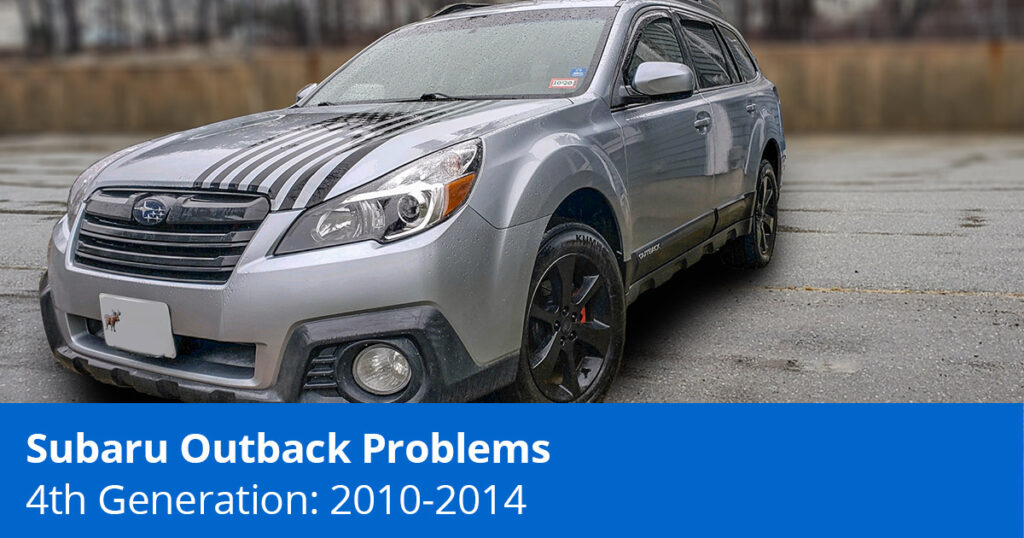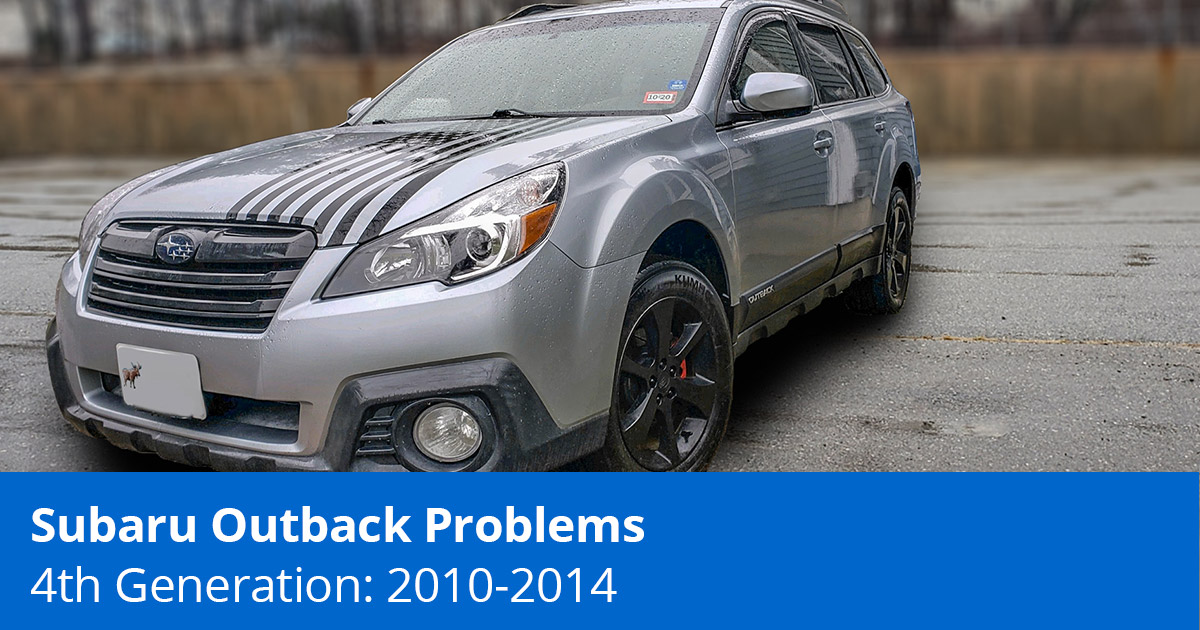
The 4th gen Subaru Outback debuted in 2009 at the New York International Auto Show. It was wider and taller than its predecessor and churned more power. Like most cars, it comes with issues that are unique to it, but this does not mean that it’s a bad car, and it has in fact received praise for its capability and advanced technology. Here are the top 5 most common 4th generation Subaru Outback problems, years 2010 to 2014.
Top 5 4th Gen Subaru Outback Problems (2010 to 2014)
1. Steering Column Shaft
Symptoms of a Bad Steering Column Shaft
- Wonky or loose steering
- Unresponsive steering
Causes of a Bad Steering Column Shaft
The steering column shaft is located right behind the steering wheel. On most vehicles, it has two pieces that are press-fitted together. These pieces tend to loosen with time on the 4th gen Subaru Outback—especially if they were not fitted well enough. It creates a wonky feeling every time you try to steer the car.
Sometimes, you may even notice that your wheels are not responding whenever you try to make a turn. Other times, they might turn left when you intend to turn right. It is one of the scariest safety issues you’ll encounter in the fourth-generation Subaru Outback. In situations where the two steering shaft pieces are completely detached, you may find the car veering off the road.
How to Fix a Bad Steering Shaft
You’ll need to have the steering shaft replaced to solve the problem. Subaru has a recall out for the issue. You can head over to them and they’ll fix it for free. Another alternative would be to replace the steering column shaft yourself if you can.
Read more about how to diagnose a steering shaft
2. Airbag Recall
Symptoms of Airbag Problems in the 4th Gen Subaru Outback
- Air bags could release too fast or explode
Causes of the Airbag Recall
The fourth-generation Subaru Outback comes with Takata airbags all over its interior. Unfortunately, they pose a great safety risk to users. In areas where there’s high humidity or fluctuating temperatures, the internal airbag system tends to accumulate moisture from the outside. The inflator that’s supposed to ensure the airbags are released to create a nice cushy surface also gets affected.
It, therefore, expels the propellant out much faster than it’s supposed to. This causes the airbag to release at a faster speed, potentially creating a safety concern that can harm passengers and push them back further than expected. In severe situations, Takata airbags are known to explode and release all the propellant onto the passenger.
How to Fix Defective Air Bags
The defective inflators have sparked a worldwide recall for over a hundred million vehicles. Subaru has a recall out for all models affected. Since you’ll only experience the symptoms in an extreme situation, it’s best not to wait. The best solution is to head over to a Subaru dealership and have the airbags replaced in your 2010 to 2014 Outback. Your safety is important.
3. Leaky Head Gaskets
Symptoms of a Faulty Head Gasket
- Smoke or smell expelling from the tailpipe
- Low coolant or oil levels with no leak
- Gurgling water noise behind the glove box
- Low engine compression
- Milky goo inside the oil cap
Causes of a Faulty Head Gasket
The head gaskets fitted in the 2.5-liter Subaru Outback are known to leak. A common symptom here includes noticing smoke or a smell coming out of your tailpipe. You may also realize that your coolant and oil are running low yet there’s no leakage. These fluids tend to go right out your exhaust from the head gasket. In some situations, they may also leak and drip to the ground.
Some 4th gen Subaru Outback owners also report hearing a gurgling noise coming from behind the glove box every time they turn on the blower. It comes from the cooling system. As the coolant is passing through there it’s also pushing air bubbles. The air contains carbon monoxide that comes from the exhaust. It gets pushed through the heater core fins, creating an annoying gurgling sound.
How to Fix a Faulty Head Gasket
To check if your coolant is contaminated, you can use a head gasket tester to test for carbon monoxide and other contaminants. The test kit comes with a fluid that changes color if there are exhaust fumes inside the cooling system. Other symptoms that you may notice include low engine compression or a milky goo inside the oil filler cap.
This problem is common in the 2.5-liter engine because it comes with a single layer gasket for the head gasket. It’s therefore, not thick enough. Going for an OE replacement part could have you experiencing the same problem after 50,000 miles. The best solution is to replace it with the 2.5-liter turbo head gasket. It’s thicker and has a metal reinforcement inside that lasts longer.
It’s important to note that replacing a head gasket isn’t the easiest job. There are several nuts and bolts, fluids, and parts that you’ll need to pay close attention to. You’re also going to have to take the head off the engine block and remove the timing chains. You may need to replace the latter if they get stretched and slack during the repair process.
4. High Oil Consumption
Symptoms of High Oil Consumption
- Ticking noise from the engine compartment
- Dashboard oil light is on
- Smoke expelling from the tailpipe after sitting idle
Causes of Excessive Oil Consumption
Excessive oil consumption is a huge deal on Subaru boxer engines. Two of the most common symptoms that you’ll notice include a ticking noise that comes from the engine compartment when you’re under load and a dashboard oil light that tells you you’re low on oil. Whenever you experience any of these, pull over immediately and add some oil.
Another less common symptom is noticing a little bit of smoke coming out of the tailpipe after the vehicle has been sitting idle for a while. This is normally a sign that your oil is burning. The cause of this is using super thin 0W-20 synthetic oil that is more common in new vehicles or a boxer engine that burns excessive oil.
The engine comes with pistons that run parallel to the ground. They put pressure on the piston rings which eventually wear out. You may, therefore, find yourself adding oil after every 500 miles. This could add up to one to two quarts of oil per 5,000 miles and up to seven quart oil changes overall. This is often too much.
How to Fix High Oil Consumption
If you hear a ticking noise from the engine compartment or the oil light turns on when driving, pull over and add oil to the engine.
Running on low oil can be dangerous and catastrophic. It’s important to have the oil consumption issues on your Subaru Outback checked. You’ll need to go down to Subaru and ask them to do an oil consumption test.
They will do a complete oil change with the manufacturer’s specified oil and replace the filter. You’ll be required to drive your vehicle as they do the test. Don’t go beyond the specified miles. You’ll also need to go back for them to drain the remaining oil and check how much of it is left. If they find out your boxer engine burns too much oil, they’ll replace your small-block engine.
5. Headlight Bulb Problems
Symptoms of Headlight Bulb Problems on the 4th Gen Subaru Outback
- Headlight bulbs burn out frequently
Causes of Headlight Bulb Problems
The headlight bulbs in the 4th gen Subaru Outback tend to burn out more frequently than your average car. The cause of this is undetermined, but it’s speculated that it could be due to a voltage spike that comes from the voltage regulator inside the alternator.
How to Fix Headlight Bulb Problems on the 4th Gen Subaru Outback
One of the best ways to confirm if a voltage spike is the cause is to connect a scan tool and graph the voltage that’s coming out of the alternator voltage regulator. You want to check for any spikes that go past 14.5 volts. This is an indication that you have a problem with your alternator. You’ll need to replace it. It’s also a great idea to replace both bulbs with high-quality options that will last long.
Replacing the headlight bulbs on the 4th gen Outback is quite a hassle. You can access the bulbs from under the hood. This may require you to remove some parts for better access. You could alternatively access the bulbs through the wheel well. You’ll need to first turn your front wheels either to the right or left depending on which side you’re working on.
The wheel well will have several push clips. Remove those to access the bulb that’s on the passenger’s side. When it comes to the driver’s side, the easiest way to access the bulbs is to remove the front bumper. You’ll also need to take out the entire headlight assembly. If both assemblies are glazed out or don’t seem to provide clear vision at night, you’ll need to replace them too.
Bonus: CVT Transmission and Front Differential Problems
Symptoms of Transmission Issues
- Strange noise underneath the vehicle when driving
How to Fix Transmission Problems on the 2010 to 2014 Subaru Outback
As a bonus, it’s crucial to highlight one user error that occurs frequently during maintenance. You’re required to service your CVT transmission and front differential after every 30,000 miles. Part of this includes changing the transmission fluid and gear oil. You’ll need to be super careful when identifying the drain and fill plugs. Many people end up putting fluid into the wrong hole.
It’s quite easy to identify the drain plug for the front differential vs the CVT transmission. The latter has a big pan underneath. However, identifying the fill plugs can be a hassle. There are a bunch of plugs under the Subaru Outback that also look like fill plugs. This makes it harder to identify which is which.
The fill plug for the front differential is located on the passenger side right above the front axle while the fill plug for the CVT transmission is located on the driver’s side. If you mess those two up, you’ll end up experiencing serious problems. For example, after draining the front differential and adding the specific fluid into the wrong hole, the front axle gets extremely hot from running without oil and produces a strange noise.
It’s only after taking a look underneath that many people notice the mistake. If you added gear oil into the CVT transmission and mixed it with the transmission fluid, you’ll need to drain it out and add the fluid and oil the right way.
Replace 4th Gen Subaru Outback Parts Yourself
Find repair videos for the 4th generation Subaru Outback in 1A Auto’s video library and fix parts like the engine air filter, brakes, headlights, wheel bearings, and more.

Shop 4th Gen Subaru Outback Parts
Related Content
- Burning Oil Smell? [Diagnose & Fix Valve Cover Gasket Leak]
- How Often Should You Change Your Oil?
- Excessive Oil Consumption: Why It Happens, How to Prevent It, and How to Fix It
- Is It Illegal to Drive with a Headlight Out?
- How Long Do Headlights Last?
- Why Are My Headlights Dim?
- How to Adjust & Aim Headlights
- Signs of transmission failure and ways to prevent it
- Is your Transmission Slipping, Jerking, or Low on Fluid?
- Types of Differentials in Automobiles
- Clunking Noise When Turning the Steering Wheel?
4th Generation Subaru Outback Model Years

